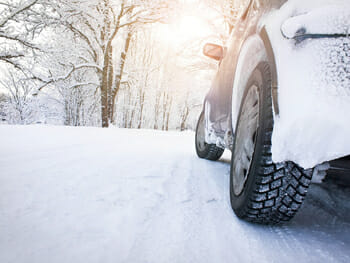
With winter come rain, sleet, ice, snow, slush, and just plain old cold and dangerous driving weather. Seventeen percent of crashes nationwide occur in winter weather conditions, according to the National Highway Transportation Safety Administration. While you probably won’t step outside when temperatures begin to drop without first donning appropriate cold-weather clothing, is your car, truck or other vehicle also safely prepared for the upcoming chill? If it isn’t, you still have time to get it done. Winterizing your vehicle will help keep it operating safely throughout the season and keep you from possibly being stranded in plummeting temperatures or, even worse, injured in an accident.
In addition to avoiding potential mechanical problems by staying on top of tune-ups and maintenance all year long, here are steps to take to get your vehicle ready for winter:
- Ensure that tires are inflated to correct psi levels for your vehicle. Your owner’s manual can advise you as to the correct level. As temperatures get colder, tires lose air, and tires that are not adequately inflated can affect maneuverability.
- Check tire tread for wear. Balding tires lose traction and are dangerous on icy and snow-covered streets. Do the penny test—with Lincoln’s head pointing down, place a penny between different raised tread areas. If the top of his head is visible, your vehicle may need new tires. A good tire shop can advise you.
- If you are using snow tires, have them put on before the first snowfall.
- Have a mechanic check the car’s engine thermostat, brakes and battery.
- Check fluid levels, including oil, antifreeze and windshield wiper fluids. To avoid wiper fluid’s freezing, switch to a wiper fluid made especially for freezing conditions.
- Be sure windshield wipers work. Consider changing wiper blades to stronger winter blades designed to handle ice and snow.
- Make sure you stay warm while driving by checking the function of your car’s heater. Also, check that all window defrosters are working correctly.
- Inspect all vehicle lights, including headlights, rear lights, brake lights and hazard lights. If any of these are not operational, have them replaced.
Finally, keep an eye on weather and road conditions and whether you may need chains along your route. In Maryland, visit www.roads.maryland.gov and click on the CHART icon to view current road conditions. Keeping an emergency kit in your vehicle that contains flares, a flashlight, a shovel, blankets, warm clothes, drinking water, and non-perishable snacks is also a good idea for winter driving. Before hitting the road, ensure that you have enough gas and clear any snow, ice and dirt from the windows, mirrors, headlights, tail lights and backup camera.
Slow down in winter weather and drive defensively, keeping your eye out for stalled or stuck cars and dangerous drivers. Other drivers on the road may not have prepared so carefully for winter.
We Are Here to Help
If you find yourself in the unfortunate situation of a car accident or have other legal concerns in Baltimore, Steve Heisler, your trusted Baltimore car accident lawyer, may be able to provide the assistance you need. Call us today at 410-625-4878 for a free initial consultation, or use our convenient and confidential form.
